Ram ProMaster 2019 Workshop Manual
Manufacturer: RAM, Model Year: 2019, Model line: ProMaster, Model: Ram ProMaster 2019Pages: 332, PDF Size: 3.66 MB
Page 51 of 332
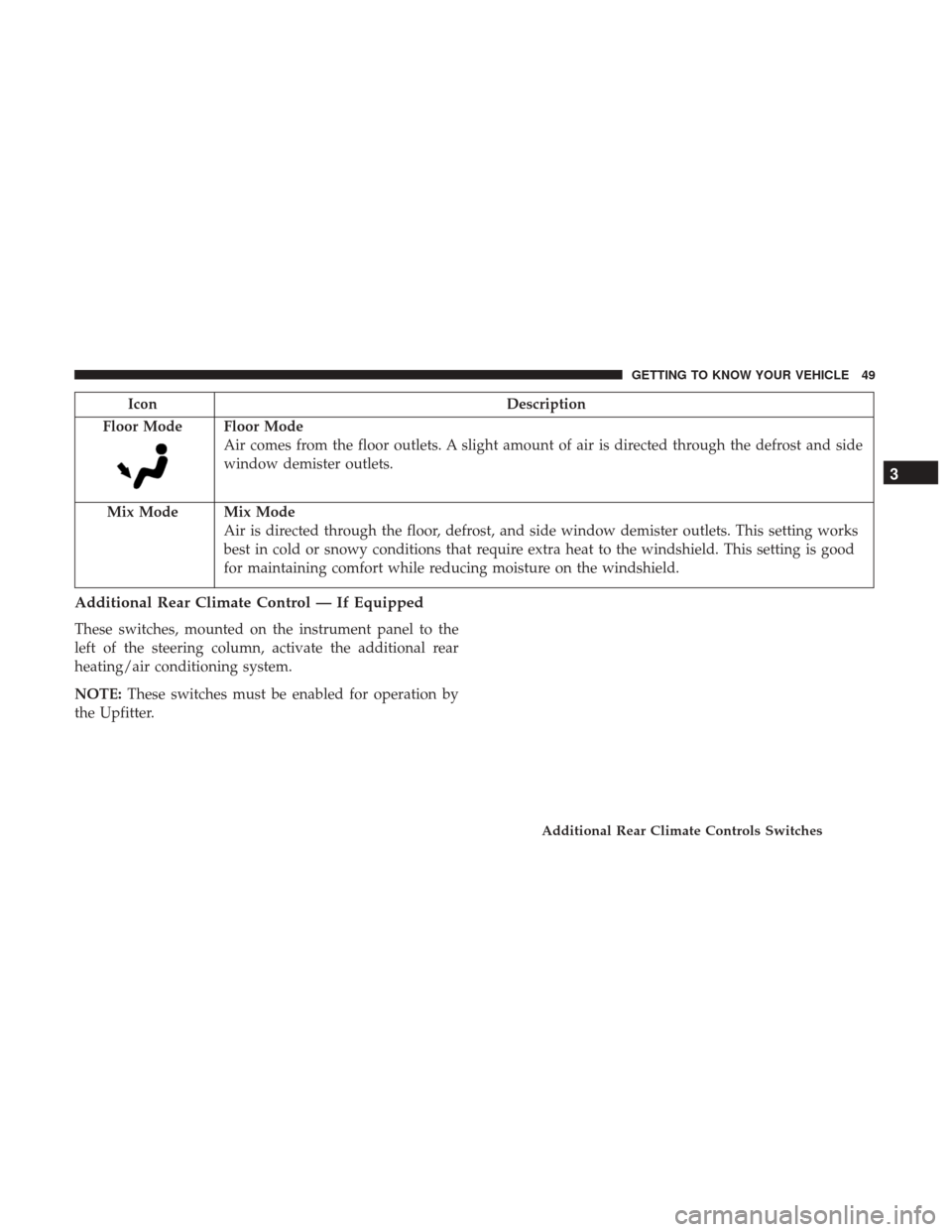
IconDescription
Floor Mode
Floor Mode
Air comes from the floor outlets. A slight amount of air is directed through the defrost and side
window demister outlets.
Mix Mode
Mix Mode
Air is directed through the floor, defrost, and side window demister outlets. This setting works
best in cold or snowy conditions that require extra heat to the windshield. This setting is good
for maintaining comfort while reducing moisture on the windshield.
Additional Rear Climate Control — If Equipped
These switches, mounted on the instrument panel to the
left of the steering column, activate the additional rear
heating/air conditioning system.
NOTE: These switches must be enabled for operation by
the Upfitter.
Additional Rear Climate Controls Switches
3
GETTING TO KNOW YOUR VEHICLE 49
Page 52 of 332
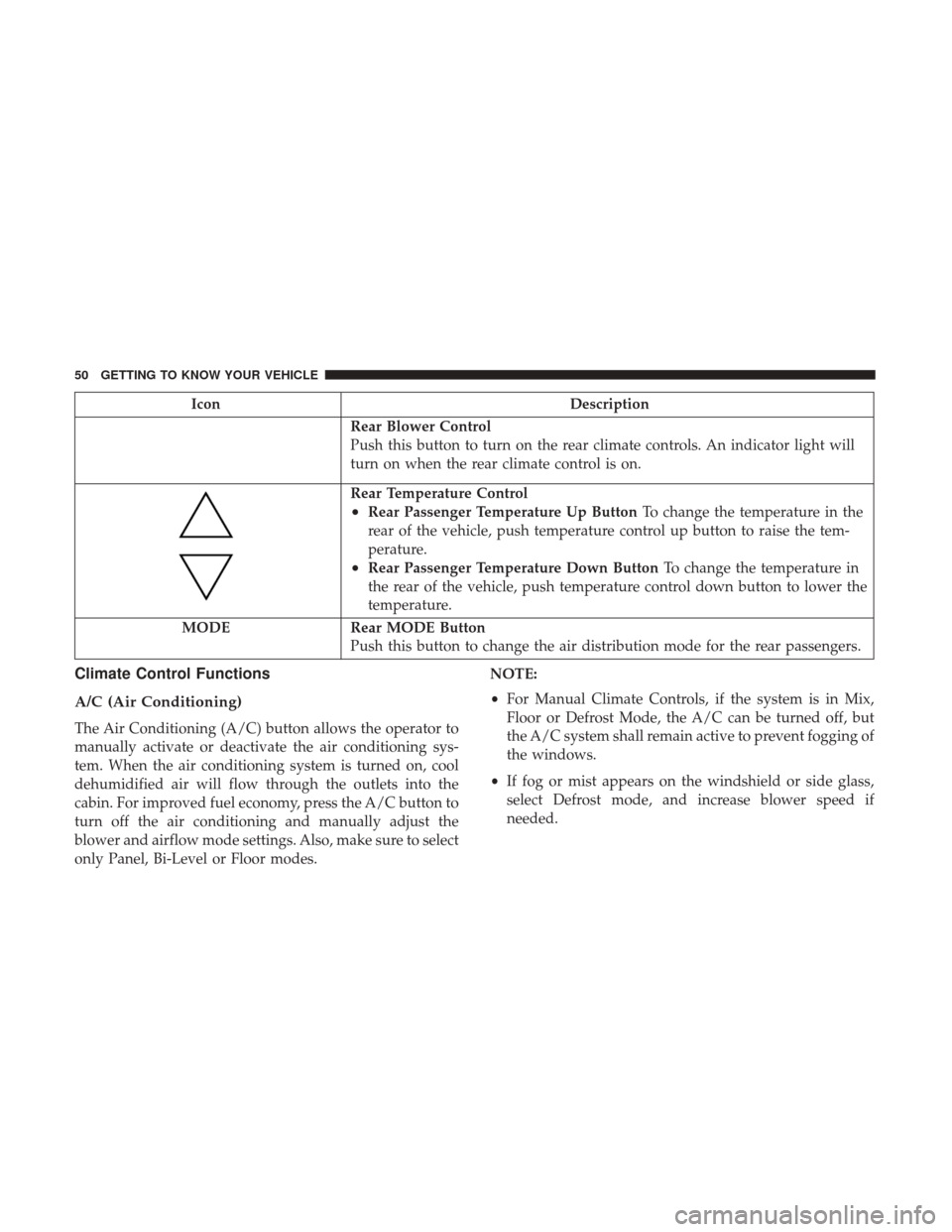
IconDescription
Rear Blower Control
Push this button to turn on the rear climate controls. An indicator light will
turn on when the rear climate control is on.
Rear Temperature Control
•Rear Passenger Temperature Up ButtonTo change the temperature in the
rear of the vehicle, push temperature control up button to raise the tem-
perature.
•Rear Passenger Temperature Down Button To change the temperature in
the rear of the vehicle, push temperature control down button to lower the
temperature.
MODE Rear MODE Button Push this button to change the air distribution mode for the rear passengers.
Climate Control Functions
A/C (Air Conditioning)
The Air Conditioning (A/C) button allows the operator to
manually activate or deactivate the air conditioning sys-
tem. When the air conditioning system is turned on, cool
dehumidified air will flow through the outlets into the
cabin. For improved fuel economy, press the A/C button to
turn off the air conditioning and manually adjust the
blower and airflow mode settings. Also, make sure to select
only Panel, Bi-Level or Floor modes. NOTE:
•
For Manual Climate Controls, if the system is in Mix,
Floor or Defrost Mode, the A/C can be turned off, but
the A/C system shall remain active to prevent fogging of
the windows.
• If fog or mist appears on the windshield or side glass,
select Defrost mode, and increase blower speed if
needed.
50 GETTING TO KNOW YOUR VEHICLE
Page 53 of 332
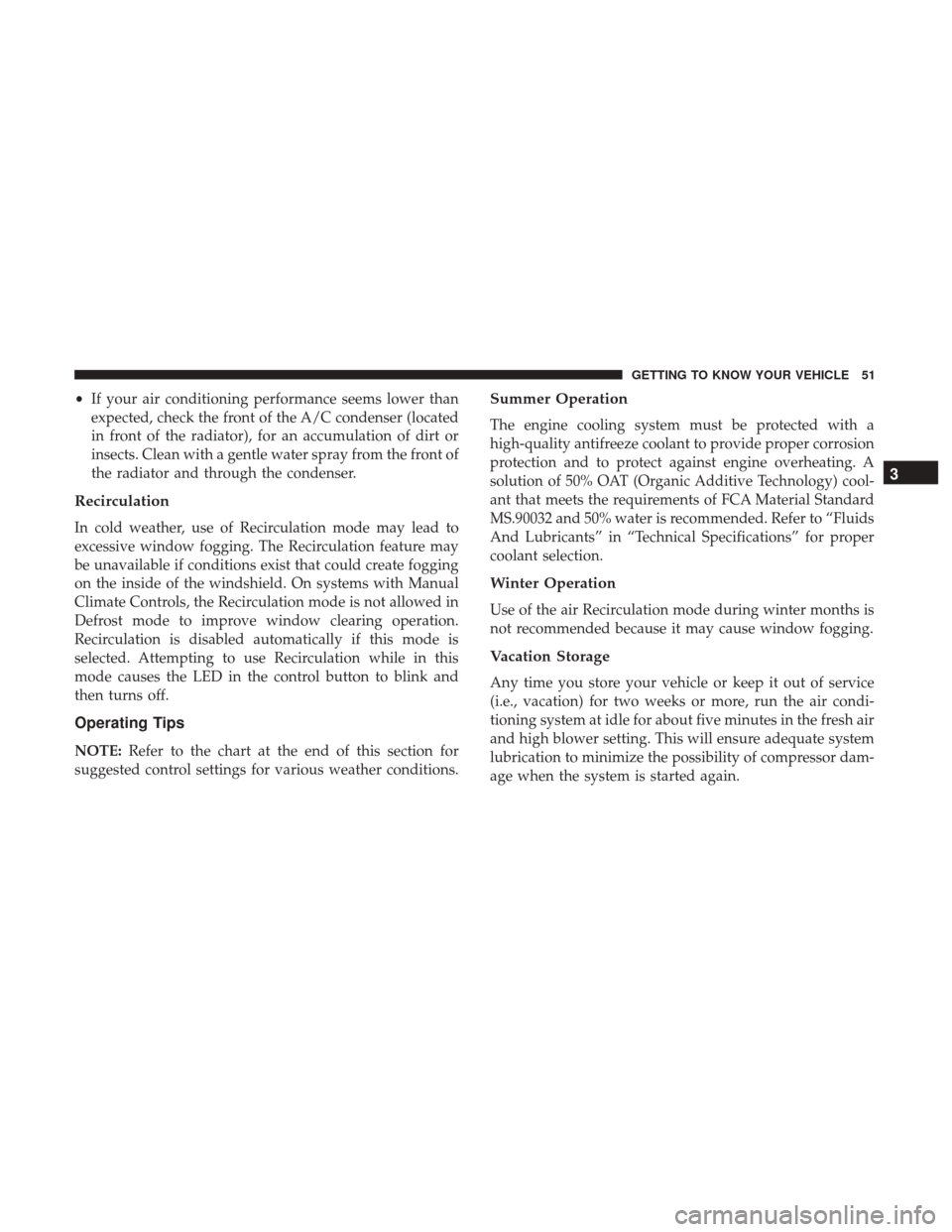
•If your air conditioning performance seems lower than
expected, check the front of the A/C condenser (located
in front of the radiator), for an accumulation of dirt or
insects. Clean with a gentle water spray from the front of
the radiator and through the condenser.
Recirculation
In cold weather, use of Recirculation mode may lead to
excessive window fogging. The Recirculation feature may
be unavailable if conditions exist that could create fogging
on the inside of the windshield. On systems with Manual
Climate Controls, the Recirculation mode is not allowed in
Defrost mode to improve window clearing operation.
Recirculation is disabled automatically if this mode is
selected. Attempting to use Recirculation while in this
mode causes the LED in the control button to blink and
then turns off.
Operating Tips
NOTE: Refer to the chart at the end of this section for
suggested control settings for various weather conditions.
Summer Operation
The engine cooling system must be protected with a
high-quality antifreeze coolant to provide proper corrosion
protection and to protect against engine overheating. A
solution of 50% OAT (Organic Additive Technology) cool-
ant that meets the requirements of FCA Material Standard
MS.90032 and 50% water is recommended. Refer to “Fluids
And Lubricants” in “Technical Specifications” for proper
coolant selection.
Winter Operation
Use of the air Recirculation mode during winter months is
not recommended because it may cause window fogging.
Vacation Storage
Any time you store your vehicle or keep it out of service
(i.e., vacation) for two weeks or more, run the air condi-
tioning system at idle for about five minutes in the fresh air
and high blower setting. This will ensure adequate system
lubrication to minimize the possibility of compressor dam-
age when the system is started again.
3
GETTING TO KNOW YOUR VEHICLE 51
Page 54 of 332
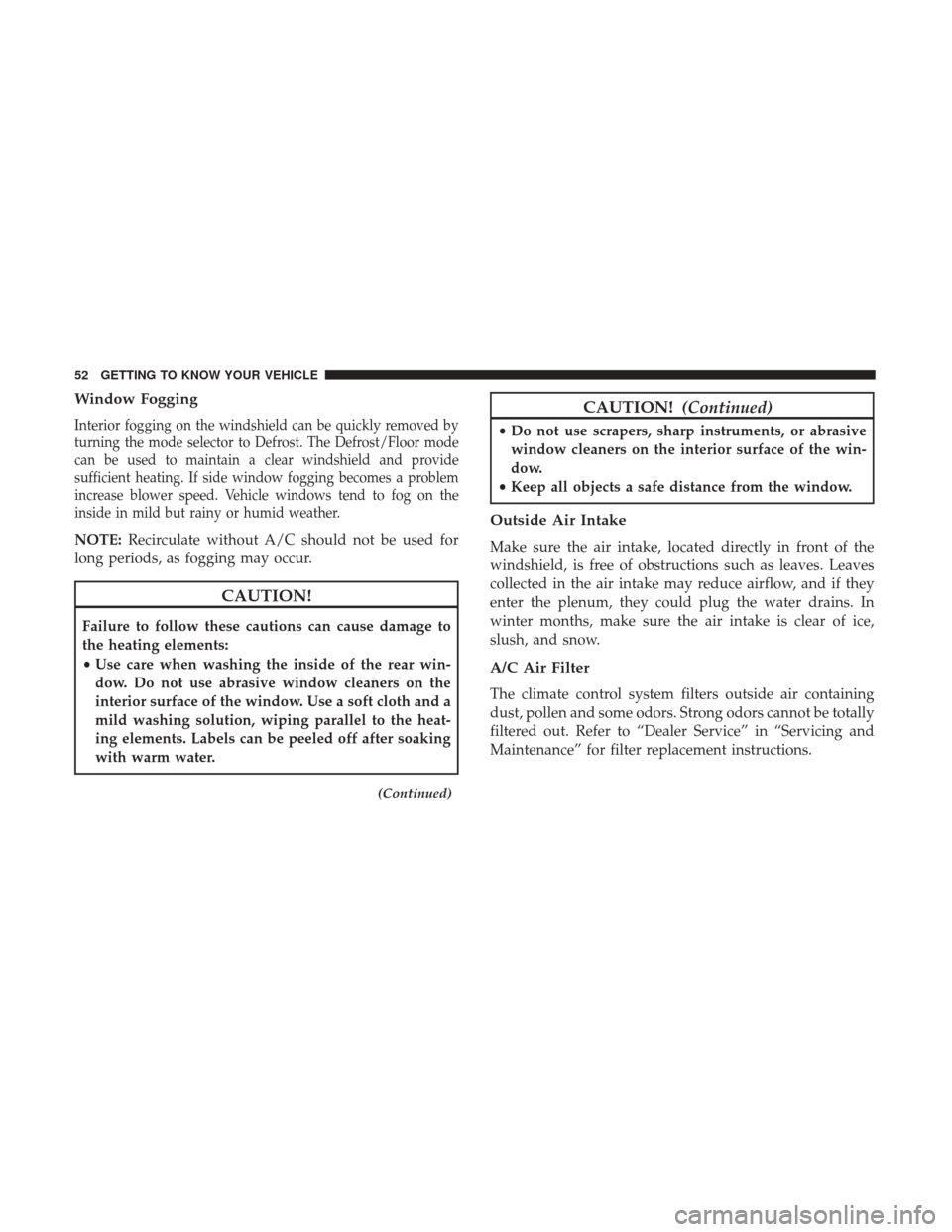
Window Fogging
Interior fogging on the windshield can be quickly removed by
turning the mode selector to Defrost. The Defrost/Floor mode
can be used to maintain a clear windshield and provide
sufficient heating. If side window fogging becomes a problem
increase blower speed. Vehicle windows tend to fog on the
inside in mild but rainy or humid weather.
NOTE:Recirculate without A/C should not be used for
long periods, as fogging may occur.
CAUTION!
Failure to follow these cautions can cause damage to
the heating elements:
• Use care when washing the inside of the rear win-
dow. Do not use abrasive window cleaners on the
interior surface of the window. Use a soft cloth and a
mild washing solution, wiping parallel to the heat-
ing elements. Labels can be peeled off after soaking
with warm water.
(Continued)
CAUTION! (Continued)
•Do not use scrapers, sharp instruments, or abrasive
window cleaners on the interior surface of the win-
dow.
• Keep all objects a safe distance from the window.
Outside Air Intake
Make sure the air intake, located directly in front of the
windshield, is free of obstructions such as leaves. Leaves
collected in the air intake may reduce airflow, and if they
enter the plenum, they could plug the water drains. In
winter months, make sure the air intake is clear of ice,
slush, and snow.
A/C Air Filter
The climate control system filters outside air containing
dust, pollen and some odors. Strong odors cannot be totally
filtered out. Refer to “Dealer Service” in “Servicing and
Maintenance” for filter replacement instructions.
52 GETTING TO KNOW YOUR VEHICLE
Page 55 of 332

Control Setting Suggestions For Various Weather
ConditionsWINDOWS
Power Windows
The control on the left front door panel has up-down
switches that give you fingertip control of all power
windows. There is a single opening and closing switch on
the front passenger door for passenger window control.
NOTE:
The Key Off Power Delay feature will allow the
power windows to operate for up to three minutes after the
ignition is turned OFF. This feature is cancelled when
either front door is opened.
Control Settings Suggestions For Various Weather
Conditions Chart
Power Window Switches
3
GETTING TO KNOW YOUR VEHICLE 53
Page 56 of 332

WARNING!
•Never leave children alone in a vehicle, or with
access to an unlocked vehicle. Allowing children to
be in a vehicle unattended is dangerous for a number
of reasons. A child or others could be seriously or
fatally injured. Children should be warned not to
touch the parking brake, brake pedal or the gear
selector.
• Do not leave the key fob in or near the vehicle or in
a location accessible to children. A child could oper-
ate power windows, other controls, or move the
vehicle.
Auto-Down Feature — If Equipped
The window switches may be equipped with an Auto-
Down feature. Push the window switch for half a second,
release, and the window will go down automatically.
To stop the window from going all the way down during
the auto-down operation, pull up or push down on the
switch briefly.
To open the window part way, lift the window switch to
the detent for less than half a second and release it to stop
the window. NOTE:
The power window switches remain active for up
to three minutes after the ignition switch has been turned
OFF. Opening either of the vehicle’s front doors will cancel
this feature.
Window Bar Grates — If Equipped
This vehicle may be equipped with metal grates over the
side door windows. This feature is a part of the vehicle’s
safety system, and is designed to protect you and your
passengers in the event of an accident.
Window Bar Grates
54 GETTING TO KNOW YOUR VEHICLE
Page 57 of 332
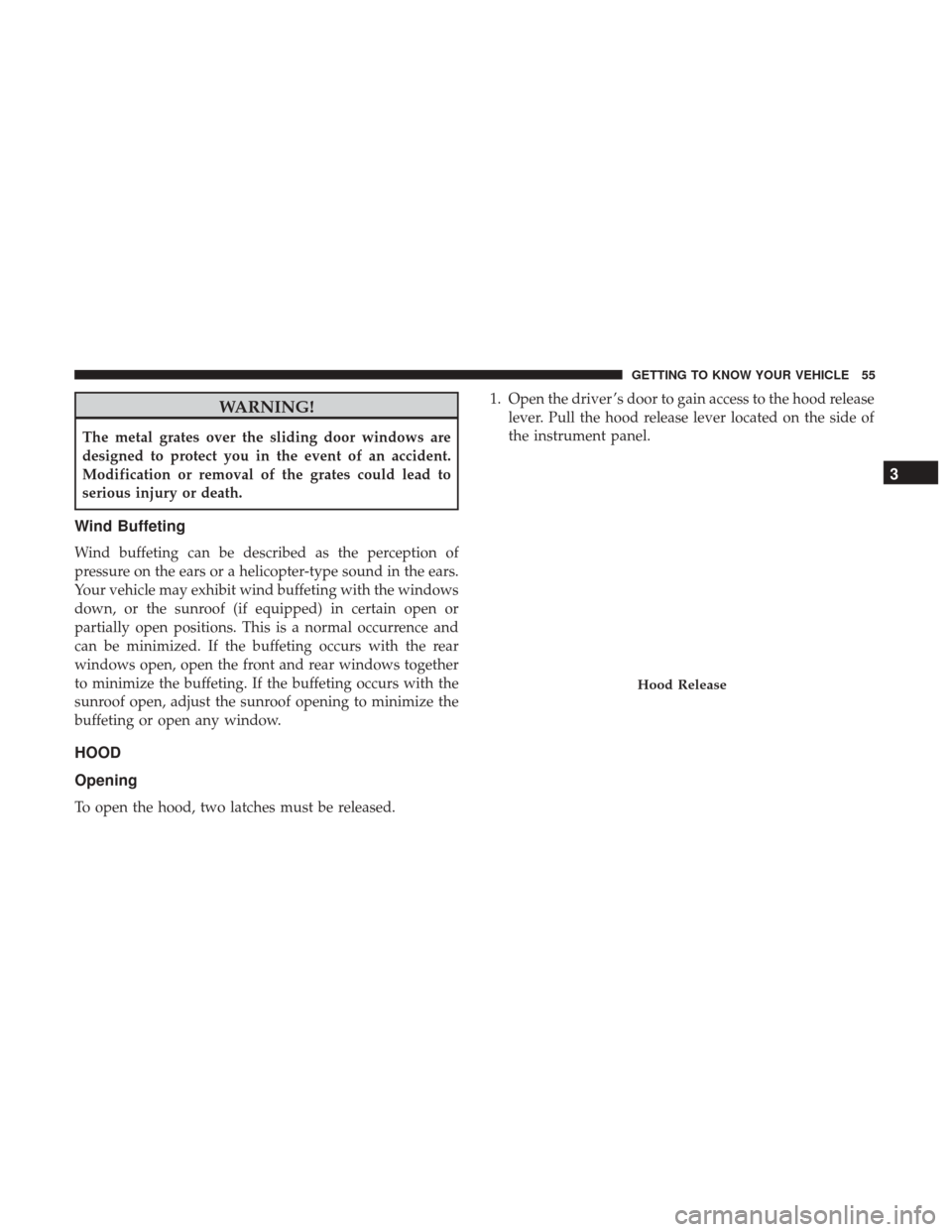
WARNING!
The metal grates over the sliding door windows are
designed to protect you in the event of an accident.
Modification or removal of the grates could lead to
serious injury or death.
Wind Buffeting
Wind buffeting can be described as the perception of
pressure on the ears or a helicopter-type sound in the ears.
Your vehicle may exhibit wind buffeting with the windows
down, or the sunroof (if equipped) in certain open or
partially open positions. This is a normal occurrence and
can be minimized. If the buffeting occurs with the rear
windows open, open the front and rear windows together
to minimize the buffeting. If the buffeting occurs with the
sunroof open, adjust the sunroof opening to minimize the
buffeting or open any window.
HOOD
Opening
To open the hood, two latches must be released.1. Open the driver ’s door to gain access to the hood release
lever. Pull the hood release lever located on the side of
the instrument panel.
Hood Release
3
GETTING TO KNOW YOUR VEHICLE 55
Page 58 of 332
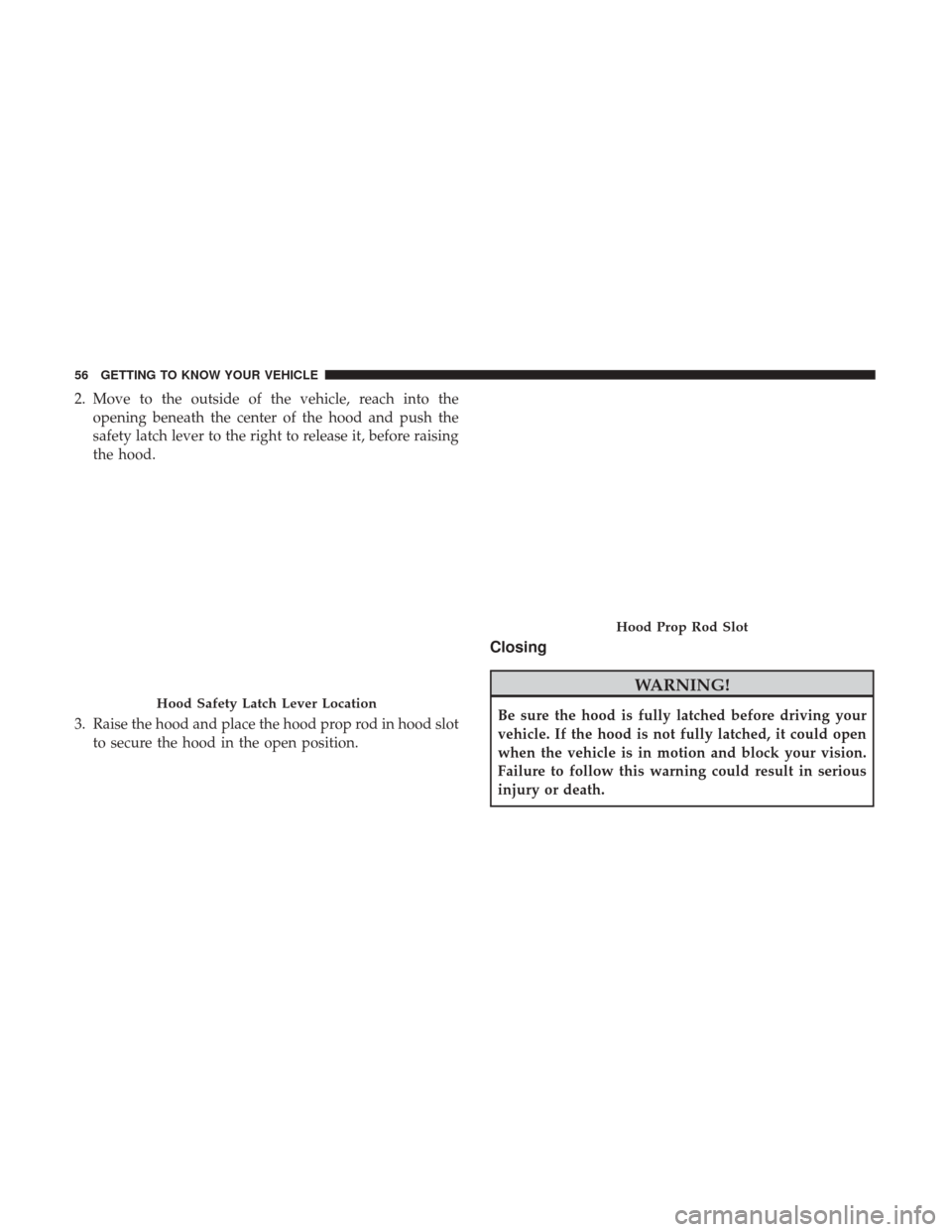
2. Move to the outside of the vehicle, reach into theopening beneath the center of the hood and push the
safety latch lever to the right to release it, before raising
the hood.
3. Raise the hood and place the hood prop rod in hood slot to secure the hood in the open position.
Closing
WARNING!
Be sure the hood is fully latched before driving your
vehicle. If the hood is not fully latched, it could open
when the vehicle is in motion and block your vision.
Failure to follow this warning could result in serious
injury or death.Hood Safety Latch Lever Location
Hood Prop Rod Slot
56 GETTING TO KNOW YOUR VEHICLE
Page 59 of 332
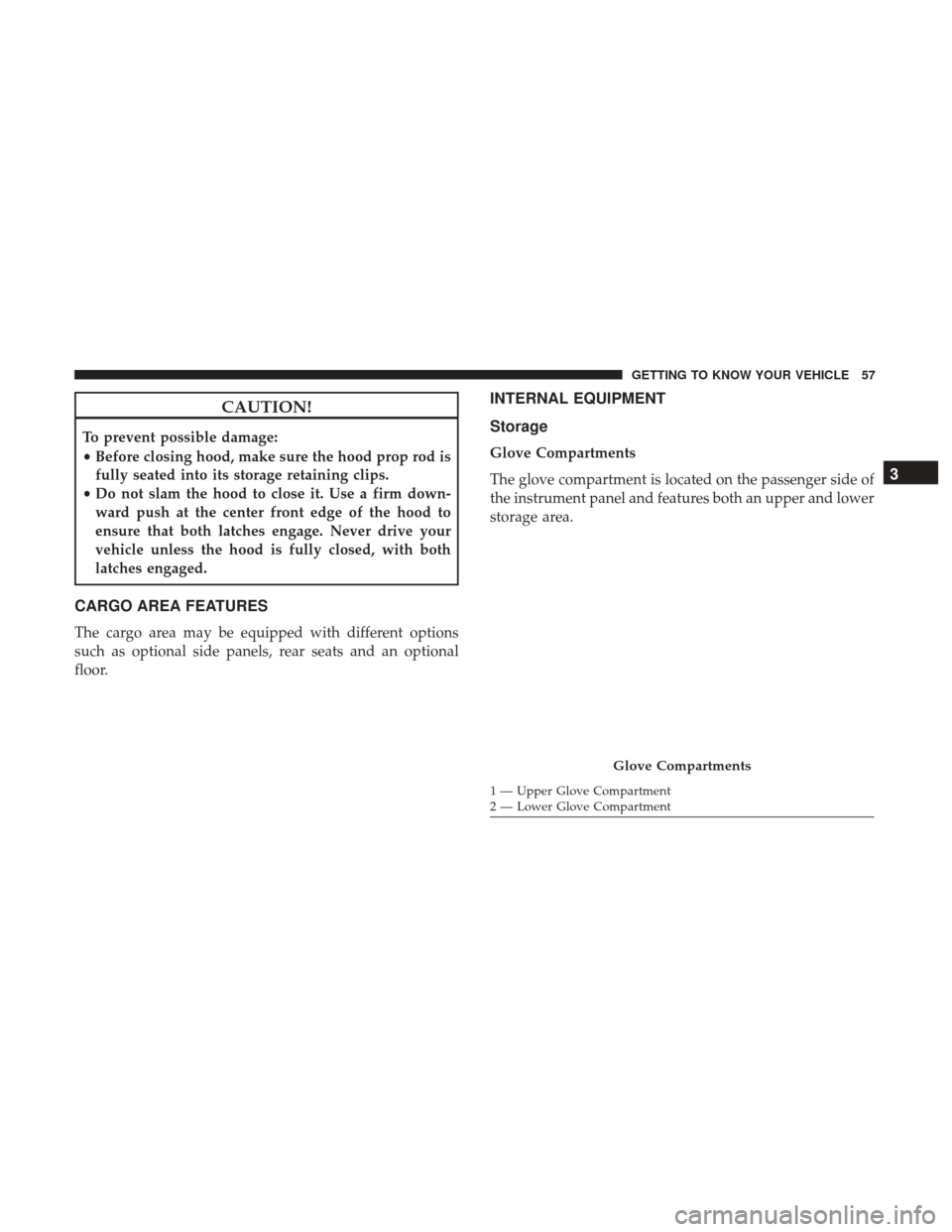
CAUTION!
To prevent possible damage:
•Before closing hood, make sure the hood prop rod is
fully seated into its storage retaining clips.
• Do not slam the hood to close it. Use a firm down-
ward push at the center front edge of the hood to
ensure that both latches engage. Never drive your
vehicle unless the hood is fully closed, with both
latches engaged.
CARGO AREA FEATURES
The cargo area may be equipped with different options
such as optional side panels, rear seats and an optional
floor.
INTERNAL EQUIPMENT
Storage
Glove Compartments
The glove compartment is located on the passenger side of
the instrument panel and features both an upper and lower
storage area.
Glove Compartments
1 — Upper Glove Compartment
2 — Lower Glove Compartment
3
GETTING TO KNOW YOUR VEHICLE 57
Page 60 of 332
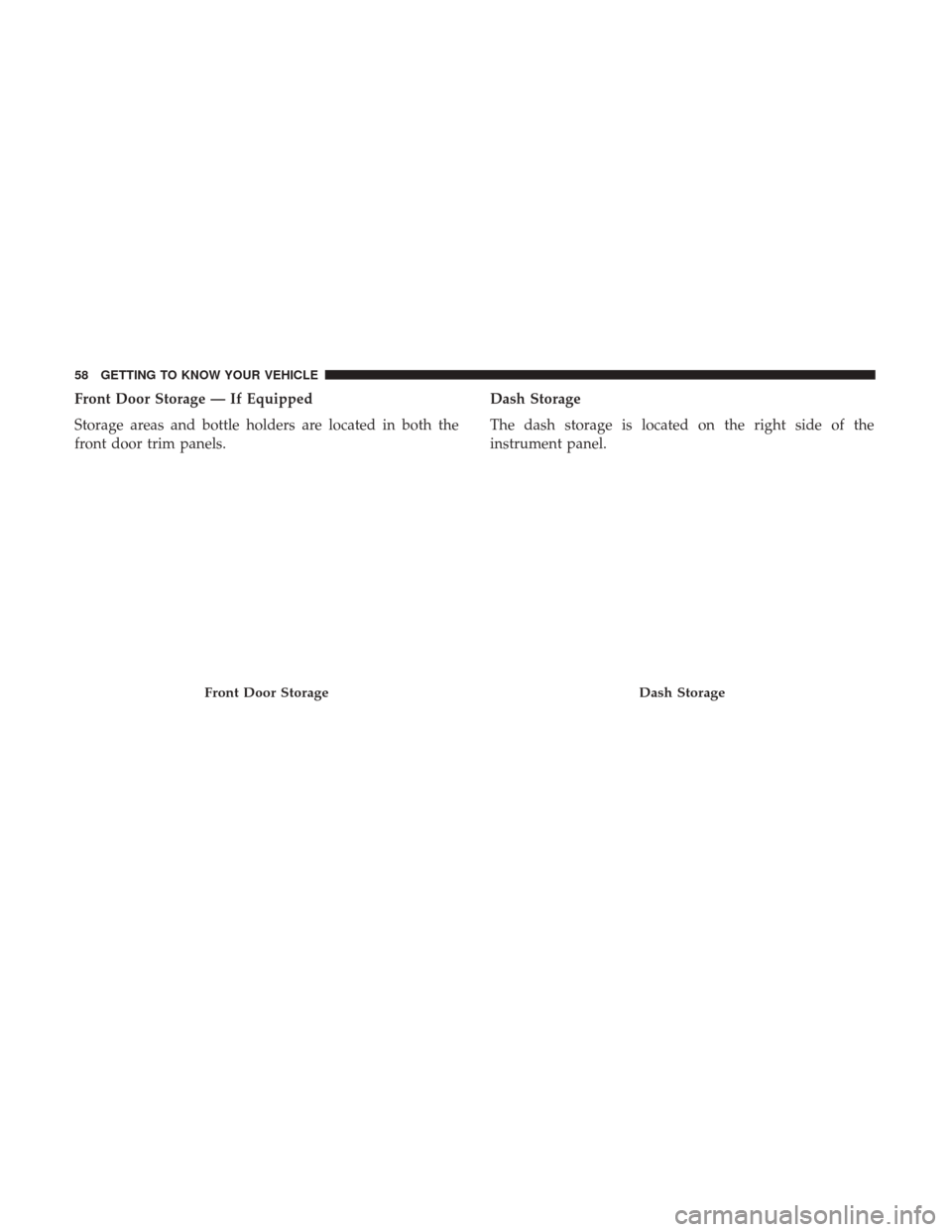
Front Door Storage — If Equipped
Storage areas and bottle holders are located in both the
front door trim panels.Dash Storage
The dash storage is located on the right side of the
instrument panel.
Front Door StorageDash Storage
58 GETTING TO KNOW YOUR VEHICLE